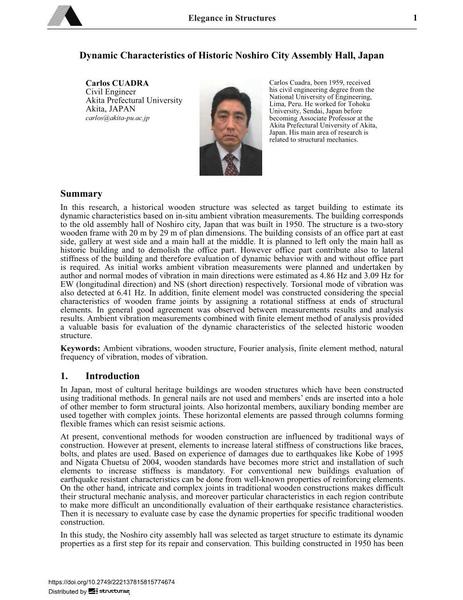Dynamic Characteristics of Historic Noshiro City Assembly Hall, Japan

|
|
|||||||||||
Bibliographic Details
| Author(s): |
Carlos Cuadra
|
||||
|---|---|---|---|---|---|
| Medium: | conference paper | ||||
| Language(s): | English | ||||
| Conference: | IABSE Conference: Elegance in structures, Nara, Japan, 13-15 May 2015 | ||||
| Published in: | IABSE Conference Nara 2015 | ||||
|
|||||
| Page(s): | 220-221 | ||||
| Total no. of pages: | 8 | ||||
| Year: | 2015 | ||||
| DOI: | 10.2749/222137815815774674 | ||||
| Abstract: |
In this research, a historical wooden structure was selected as target building to estimate its dynamic characteristics based on in-situ ambient vibration measurements. The building corresponds to the old assembly hall of Noshiro city, Japan that was built in 1950. The structure is a two-story wooden frame with 20 m by 29 m of plan dimensions. The building consists of an office part at east side, gallery at west side and a main hall at the middle. It is planned to left only the main hall as historic building and to demolish the office part. However office part contribute also to lateral stiffness of the building and therefore evaluation of dynamic behavior with and without office part is required. As initial works ambient vibration measurements were planned and undertaken by author and normal modes of vibration in main directions were estimated as 4.86 Hz and 3.09 Hz for EW (longitudinal direction) and NS (short direction) respectively. Torsional mode of vibration was also detected at 6.41 Hz. In addition, finite element model was constructed considering the special characteristics of wooden frame joints by assigning a rotational stiffness at ends of structural elements. In general good agreement was observed between measurements results and analysis results. Ambient vibration measurements combined with finite element method of analysis provided a valuable basis for evaluation of the dynamic characteristics of the selected historic wooden structure. |
||||
| Keywords: |
finite element method (FEM) wooden structure ambient vibrations Fourier analysis natural frequency of vibration modes of vibration
|
||||
